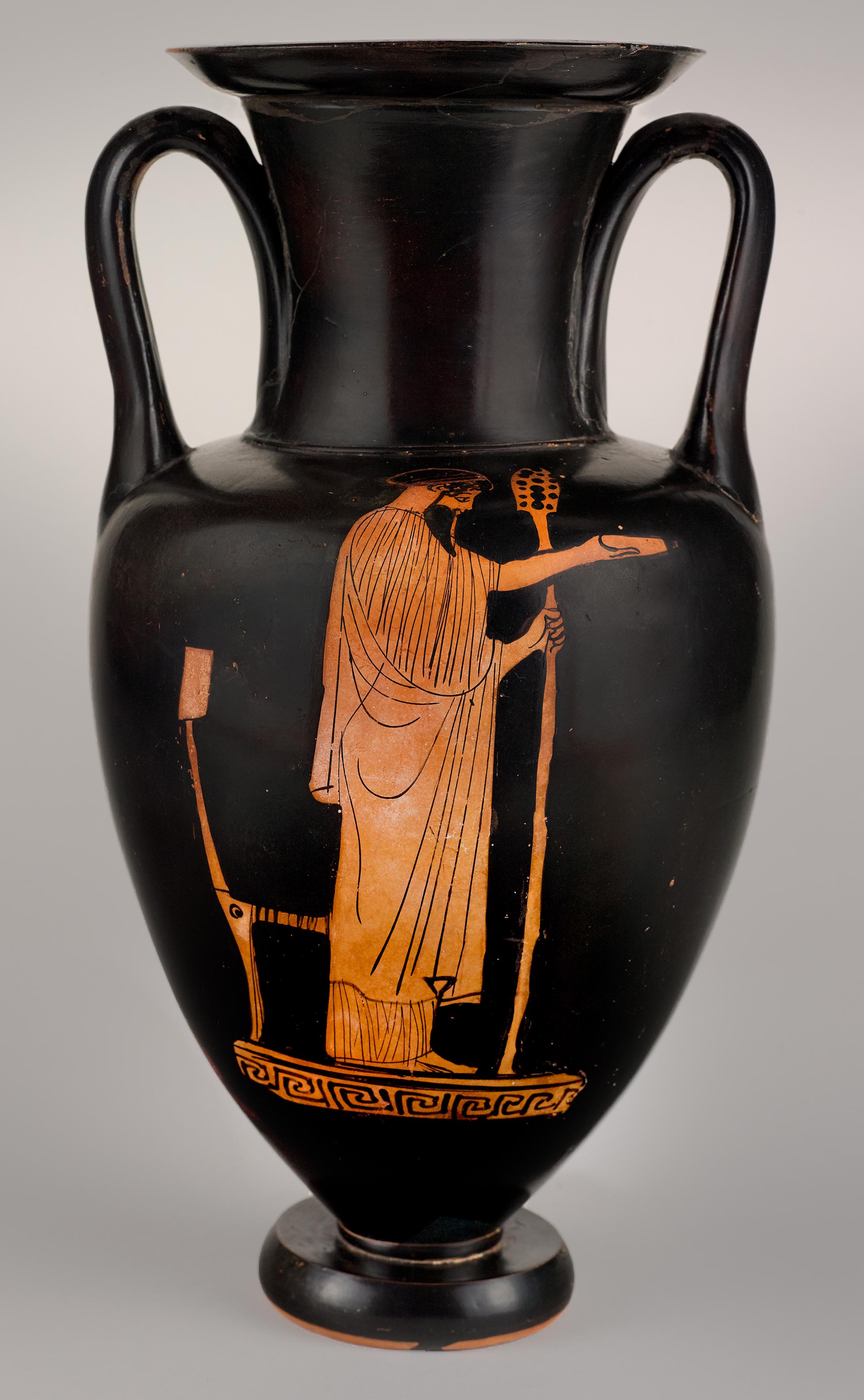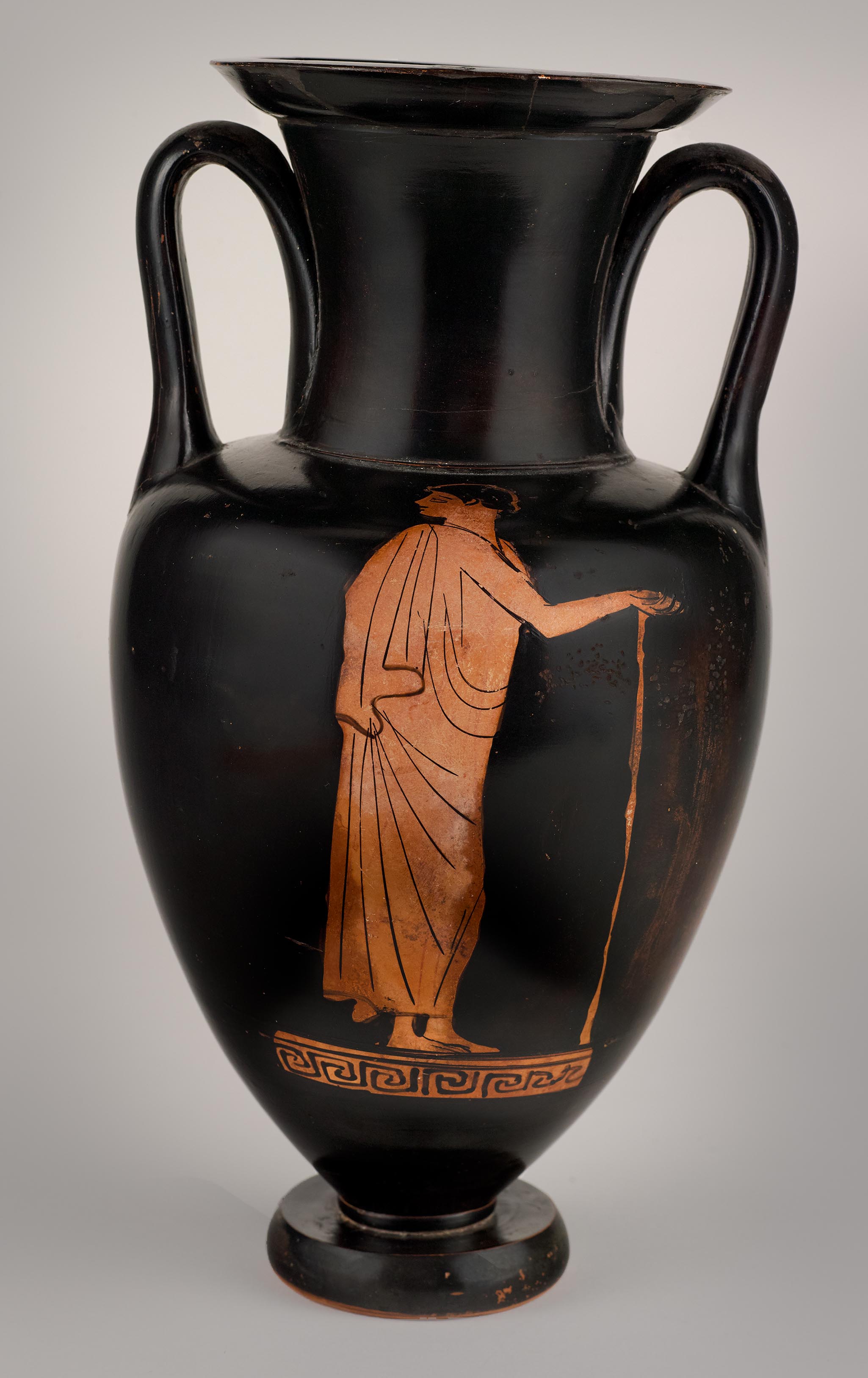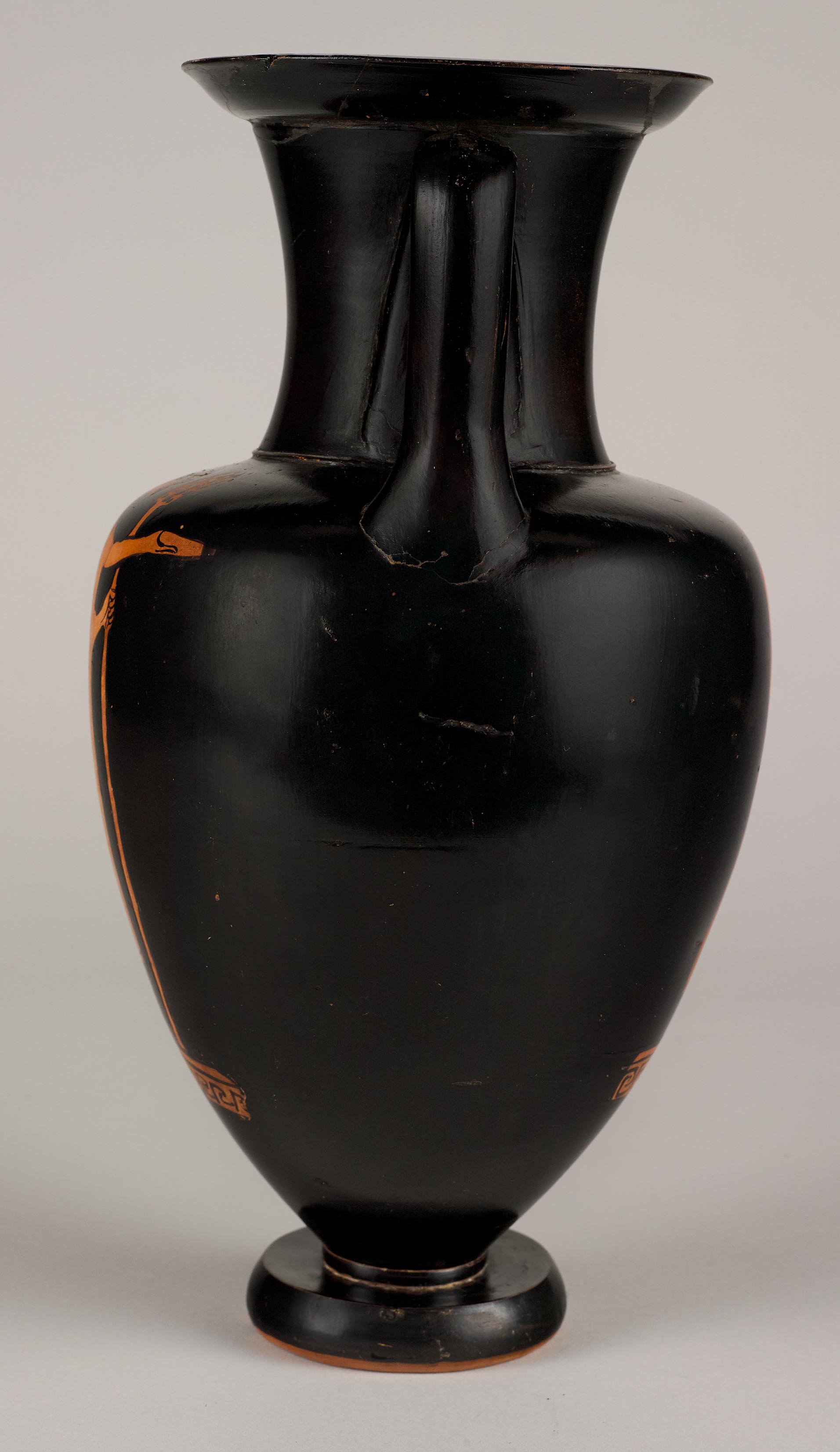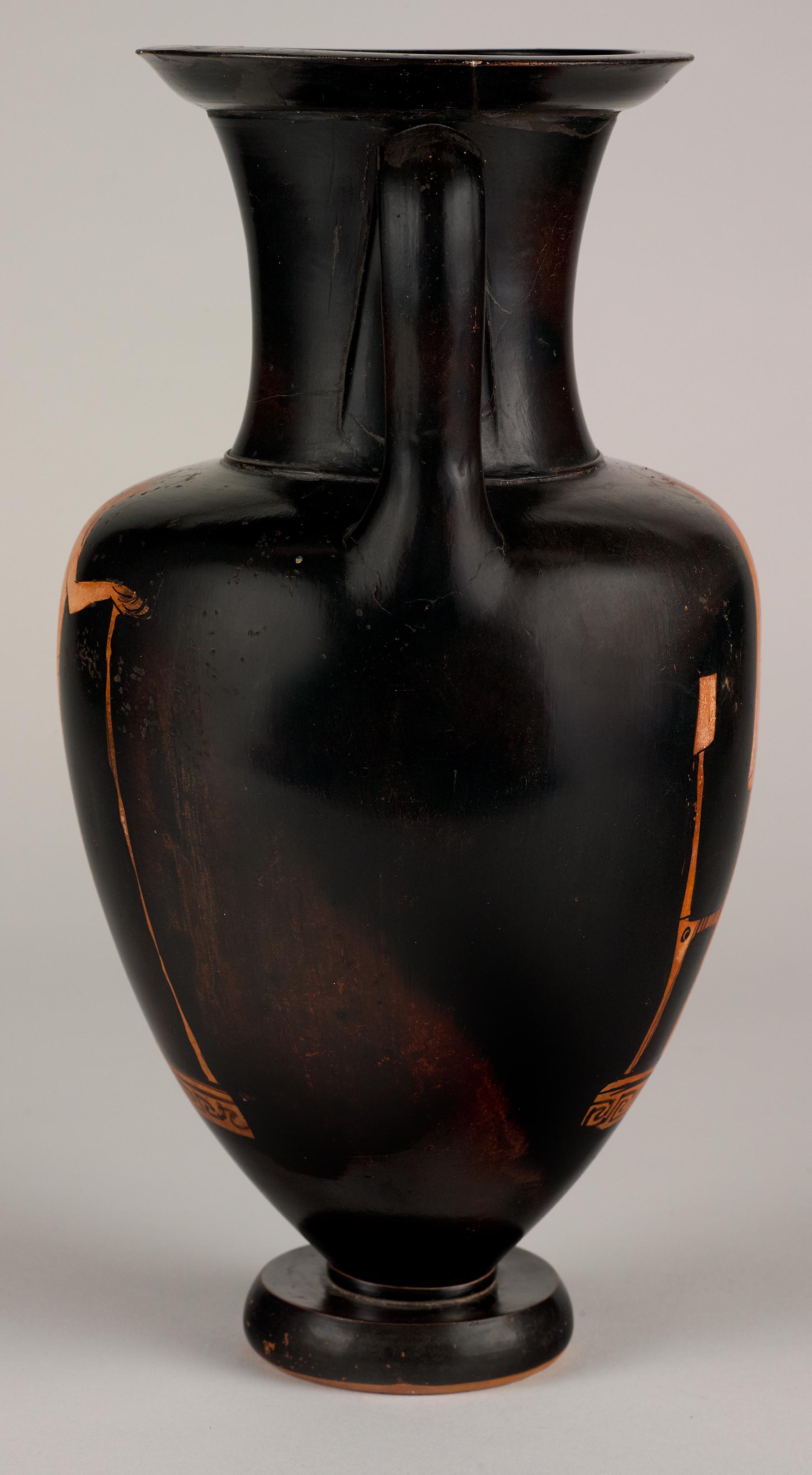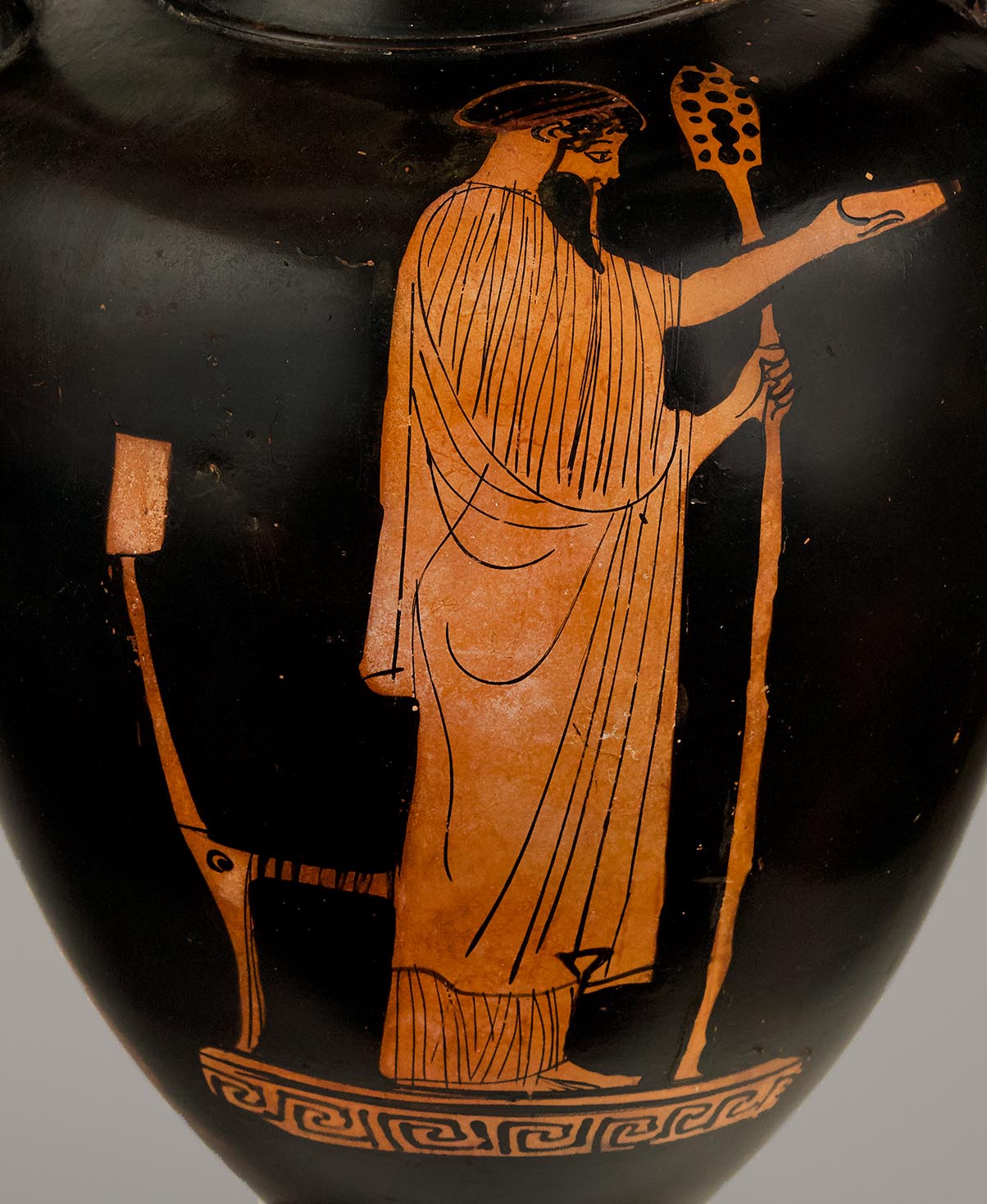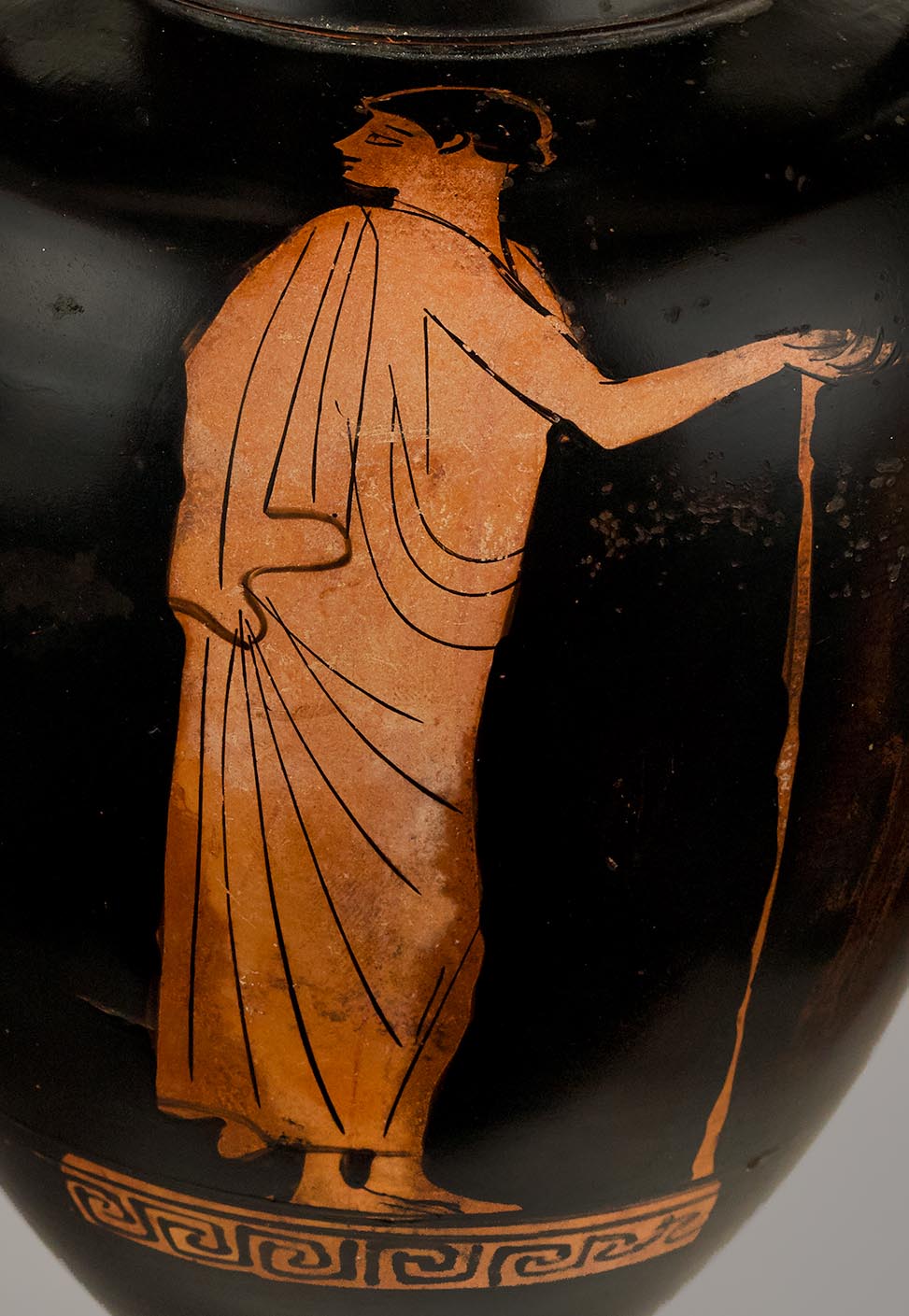Provenance
1963, Münzen und Medaillen AG (Basel); 1966, Royal Athena Galleries (New York, NY); by 1976, Emily T. Vermeule and Cornelius C. Vermeule III (Cambridge, MA) (the vase was listed as a loan from the Vermeules in a catalogue for a 1976 exhibition at the University of South Texas [infra]); 1997, gift, Emily T. Vermeule and Cornelius C. Vermeule III to Princeton University.
Shape and Ornament
Echinus mouth with concave interior, flat on top, black. Tall, slightly concave neck, interior black; thin ridge at base of neck. Ridged handles, triangular in section, black. Below figures on both sides, cursorily executed stopt meanders, which degenerate into a key pattern at the right. Disk foot separated from body by narrow fillet; top and side of foot black, except for bottom edge of the side; resting surface and underside reserved. Upper surface of the foot slightly concave.
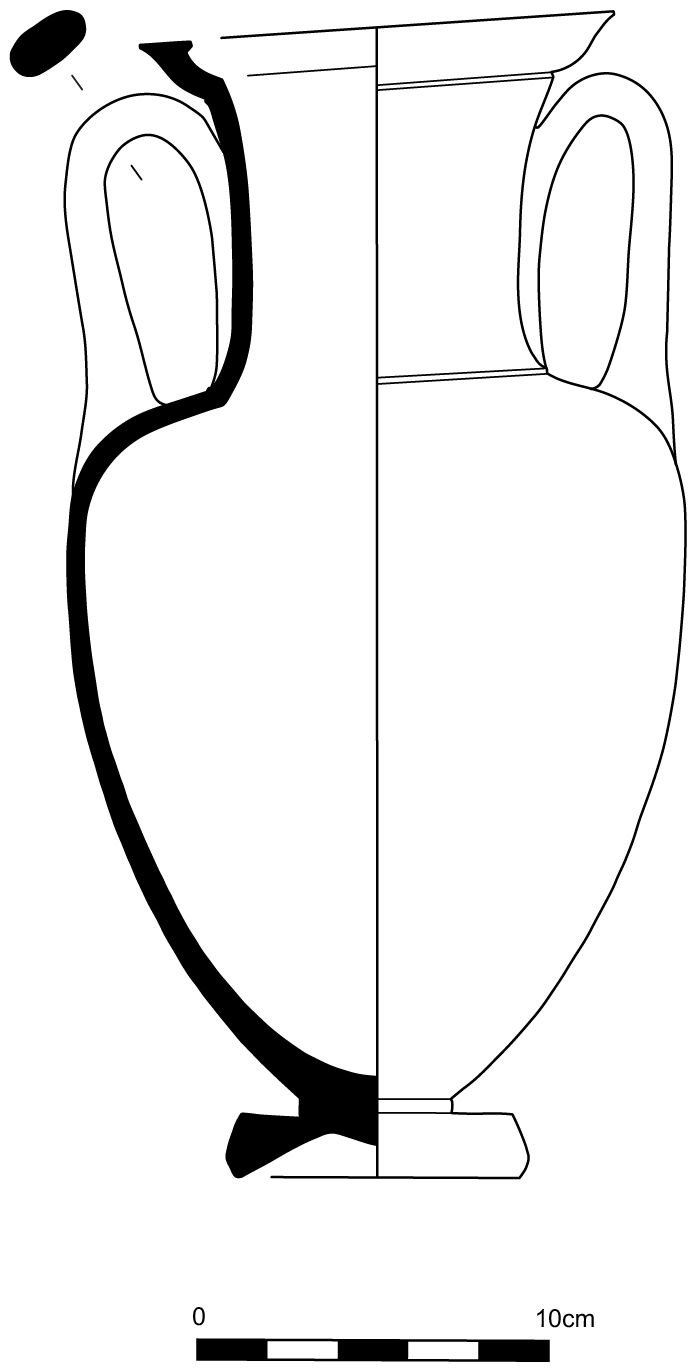
Subject
A. Dionysos. The god, wearing a chiton and himation, stands barefoot in profile to the right, with a phiale raised in his right hand to pour a libation. His hair is bound by three fillets executed in added red. He grips a thyrsos in his left hand, held upright and resting on the ground. Beside him, at left, is a klismos.
B. Youth. The youth, beardless and wearing a himation, stands in profile to the right and turns his head back to the left. His feet are staggered, with his legs slightly bent. He grips the top of a walking stick in his right hand, held upright and resting on the ground. His left arm is not visible.
Attribution and Date
Attributed to the Painter of London E 342 [J. D. Beazley]. Circa 470–460 BCE.
Dimensions and Condition
h. 33.2 cm; w. 17.7 cm; diam. of mouth 13.6 cm; diam. of foot 8.5 cm. Nearly complete, with several mended breaks, in particular around the rim. Small, shallow chips in the surface around the youth. Black gloss slightly mottled on the outer surface of the foot, and misfired streaky red on the lower body beneath handle BA.
Technical Features
Preliminary sketch. Relief contours used sparingly, such as on the chin and cheek of the youth on side B. Accessory color. Red: Dionysos’s fillets. Dilute gloss: cords of the chair seat.
Inscriptions
Incised graffito under foot:
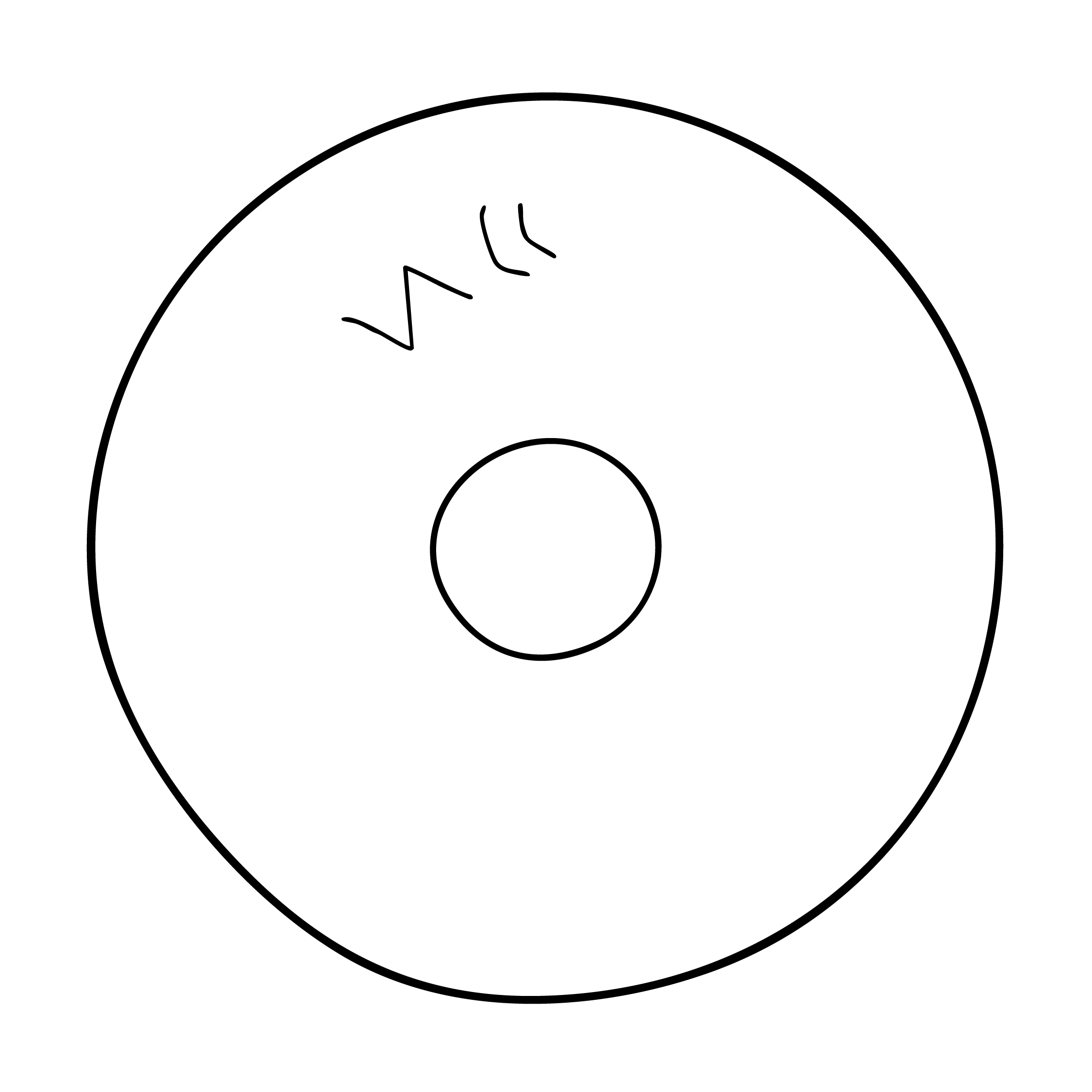
Bibliography
Abbreviation: ARV2J. D. Beazley. Attic Red-Figure Vase-Painters. 2nd ed. Oxford, 1963 1664.3 bis; Royal‑Athena Galleries, Art of the Ancient World 2, auc. cat. (New York, NY, 1966), no. 16; Greek Vases from the Boston Museum of Fine Arts, exh. cat., Art Museum of South Texas (Corpus Christi, TX, 1976), no. 32; M. Braverman, The Classical Shape: Decorated Pottery of the Ancient World, exh. cat., St. Paul’s School (Concord, NH, 1984), no. 25; Abbreviation: Princeton RecordRecord of the Princeton University Art Museum. (1942– ). 57 (1998): 196 [not illus.]; Abbreviation: BAPDBeazley Archive Pottery Database. http://www.beazley.ox.ac.uk 275309.
Comparanda
For the Painter of London E 342, see Abbreviation: ARV2J. D. Beazley. Attic Red-Figure Vase-Painters. 2nd ed. Oxford, 1963 667–72, 1664; Abbreviation: ParalipomenaJ. D. Beazley. Paralipomena: Additions to Attic Black-Figure Vase-Painters and to Attic Red-Figure Vase-Painters. Oxford, 1971 404, 424, 514, 521; Abbreviation: BAdd2Carpenter, T. H., ed. 1989. Beazley Addenda: Additional References to ABV, ARV2, and Paralipomena. 2nd ed. Oxford: Published for the British Academy by Oxford University Press. 278. He primarily decorated Nolan amphorae, with meanders, either stopt or continuous, as his preferred groundline. For their degeneration into a simple key pattern, cf. Vienna 904 (Abbreviation: ARV2J. D. Beazley. Attic Red-Figure Vase-Painters. 2nd ed. Oxford, 1963 668.25; Abbreviation: BAPDBeazley Archive Pottery Database. http://www.beazley.ox.ac.uk 207819). For a close parallel for the pairing of Dionysos in front of a klismos with a draped youth on the reverse, cf. Brussels R 249 (Abbreviation: ARV2J. D. Beazley. Attic Red-Figure Vase-Painters. 2nd ed. Oxford, 1963 668.38; Abbreviation: BAPDBeazley Archive Pottery Database. http://www.beazley.ox.ac.uk 207833).
According to Euwe, the Nolan amphorae by the Painter of London E 342 “form a special class and were most likely all made by one potter,” and Princeton’s amphora should be added to this potter’s oeuvre: H. Euwe, “The Nolan Amphorae in Dutch Collections and Their Potters,” Abbreviation: BABeschBulletin antieke beschaving. Annual Papers on Classical Archaeology 64 (1989): 130. The heights of the Nolans by this potter vary considerably, with most between 23 and 28 cm. Princeton’s example is one of the largest by his hand and presumably one of his earlier works as well, as small Nolan amphorae become popular again after about 455. An early date is also suggested by the fact that the handles do not project beyond the diameter of the body, and by the slow taper of the body—both features characteristic of Euwe’s developed phase (around 480–460): H. Euwe, “The Shape of a Nolan Amphora in Otterlo,” in Enthousiasmos: Essays on Greek and Related Pottery Presented to J. M. Hemelrijk, ed. H. A. G. Brijder, A. A. Drukker, and C. W. Neeft (Amsterdam, 1986), 142. The sunken upper surface of the foot also recommends such a date. The ratio of height to diameter, nearly 2:1, as well as the long neck, suggests that this vase is at the end of the developed phase, at the beginning of the transition to the slenderer amphorae of the mid-fifth century. As Euwe noted (“Nolan Amphorae in Dutch Collections,” 130), the amphorae painted by the Painter of London E 342 are marked by certain irregularities of shape. Princeton’s amphora has an uneven mouth and is slightly lopsided, with the body extending at an oblique angle from the flat foot.
Scenes of deities making self-referential libations increase dramatically in Early Classical vase-painting. For the idea that such scenes are paradigms for mortal behavior, in which human religious activity is projected onto the divine realm, see E. Mitropolou, Libation Scenes with Oinochoe in Votive Reliefs (Athens, 1975), 88–90. For the view that the phiale does not actually represent libation but is rather used as an attribute of the god, emphasizing his or her divinity, see P. Veyne, “Images de divinités tenant une phiale ou patère: La libation comme ‘rite de passage’ et non pas offrande,” Abbreviation: MètisMètis: Anthropologie des mondes grecs anciens 5 (1990): 17–29. Eckstein-Wolf has argued that the phiale acts as a mediator between human and divine, with the pictured divinity functioning merely as an extension of the numinous flow from the phiale: B. Eckstein-Wolf, “Zur Darstellung spendender Götter,” Abbreviation: MdIMitteilungen des Deutschen Archäologischen Instituts 5 (1952): 39–75. Simon has related various libating gods to specific events of myth or ritual, although it is difficult to incorporate completely isolated gods into this line of inquiry: E. Simon, Opfernde Götter (Berlin, 1953). More recently, Patton has suggested that scenes of libating gods represent a form of divine reflexivity, in which the depicted gods establish and promote their own worship: K. C. Patton, Religion of the Gods: Ritual, Paradox, and Reflexivity (Oxford, 2009), 170–80. For the argument that libating gods offer an opportunity for mortal viewers to affirm their bonds with the anthropomorphic gods while also contemplating the alterity of the god, see M. Gaifman, The Art of Libation in Classical Athens (New Haven, CT, 2018), 117–49. For an overview of the topic, with complete bibliography, see Abbreviation: Smith, Religion in the ArtSmith, T. J. 2021. Religion in the Art of Archaic and Classical Greece. Philadelphia: University of Pennsylvania Press., 75–76.
No clear parallel has been found for the graffito on the underside of the foot. The mark could be related to Johnston’s type 9F (Abbreviation: Johnston, TrademarksJohnston, A. W. 1979. Trademarks on Greek Vases. Warminster: Aris and Philips., 156–57), which occurs on another Nolan amphora by the Painter of London E 342: Boston 90.157 (Abbreviation: ARV2J. D. Beazley. Attic Red-Figure Vase-Painters. 2nd ed. Oxford, 1963 667.19; Abbreviation: BAPDBeazley Archive Pottery Database. http://www.beazley.ox.ac.uk 207813). The graffito in Princeton, however, lacks the V characteristic of the group, and parallels for the equation of a retrograde nu with the sign NV are so far wanting. In general, the mark occurs quite often with numerals, such as the gamma sign on Princeton’s amphora, which may be an indication of price. (We are grateful to A. W. Johnston for sharing his thoughts on this trademark.) For a discussion of the numerals associated with the sign, see Abbreviation: Johnston, Trademarks, AddendaJohnston, A. W. 2006. Trademarks on Greek Vases: Addenda. Oxford: Oxford University Press., 150–51.
